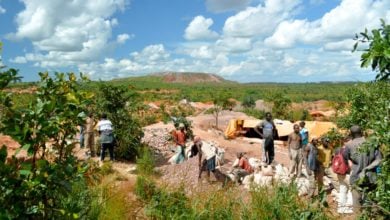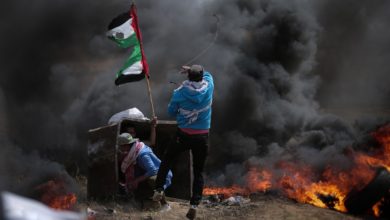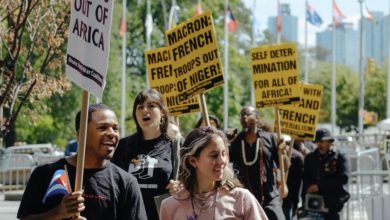Following the victory of striking workers at the Lonmin mine made famous by the Marikana massacre, gold and platinum workers across South Africa have been putting down their tools and launching open-ended strikes demanding humane wages and working conditions from the super-rich mining bosses at the top of South Africa’s capitalist economy.
The heroic actions of the Marikana workers caused significant economic pain to the owners of Lonmin, forcing them to agree to wage increases of between 11 to 22 percent and a bonus for returning to work. This signal victory has helped to spur on striking miners elsewhere in the country, and has mine owners terrified of the growing strike movement.
In the wake of the Marikana massacre, mineworkers across the country have brought into clear focus the poverty and exploitation stalking working people across the nation. At the same time, state police forces have launched raids of working-class communities, allegedly looking for weapons.
Over two decades since the formal end of apartheid, the conditions for working people and residents of rural areas have barely improved, while the profit-making corporations have continued to prosper. The question is: How could this happen? South Africa has been under the leadership of the African National Congress since the end of apartheid. How could the ANC, leaders of one of the 20th century’s most heroic struggles, have come to serve the exploitative interests of capital?
Apartheid in crisis
By the 1980s, South Africa’s apartheid government was embroiled in a crisis. Its position in the international capitalist establishment was starting to become unhinged by a combination of factors. With an economy based primarily on mineral extraction, South Africa was significantly hobbled when the bottom fell out of the international gold market in 1981. In 1979, with the fall of the Shah in Iran, the apartheid chieftains lost their key oil supplier. The Shah had flouted international sanctions to ship large supplies of oil to keep the racist machinery running.
Further, the strength of the international boycott movement caused some international corporations like Kodak to withdraw totally from South Africa. Others such as IBM and Coca-Cola modified or reduced their investments, slowing the flow of foreign capital into the country. Between 1985 and 1989 alone South Africa lost between $32 and $40 billion as a result of sanctions and reduced international trade.
Put into the broader political context of the time was the fact that the major imperialist nations, for whom South Africa was a key link in their international network of exploitation, were less willing to defend the racist state, whose policies were becoming more of a hindrance than a help in the process of capital accumulation. The lack of support from their former imperialist partners meant South African capitalists had nowhere to turn to ameliorate economic problems, or to obtain investment to further develop their economic structure. Without a doubt, capitalists in Pretoria and Johannesburg felt the noose tightening around their necks.
Even worse for them, the fire under their feet was growing as well. The mass movement inside the country was making the country practically ungovernable. Inside the townships, as well as the workplaces, the majority-Black population was escalating the level of struggle massively.
In 1981, over 50,000 mine workers struck, something repeated again in 1984; strikes by auto and metal workers also took place in 1981 and 1982. On May Day 1986, several trade union formations led 1.5 million Black workers in a tremendous demonstration, taking the day off in defiance of the apartheid regime. In 1987, over 300,000 mine workers stayed off the job for over three weeks in the “Great Miners’ Strike.” For months, working people in Gauteng and the Cape engaged in a rent strike against usurious rent hikes, a form of struggle repeated by residents in Soweto who in 1986 forced the apartheid forces to repeal a hike in utility prices.
Protests shook many of the major townships on a regular basis, and collaborators had their businesses, cars and homes torched for their traitorous support for the racist South African state; some were even killed for their criminal acts in oppressing their own people. Armed forces from the ANC and Pan-Africanist Congress increased their actions throughout the decade with explosions and acts of sabotage beginning to take place on a daily basis.
Fundamentally the apartheid government had lost control over the majority of the Black population, who were in open revolt against the racist apartheid system.
Plotting and planning
The apartheid forces sought to manage the situation by offering a series of “concessions,” together with a significant increase in repression towards the mass movement rocking the country. In 1982, the apartheid government instituted the Black Local Authorities Act, which sought to shift minor responsibilities in designated Black majority areas to local African representatives.
In no mood for half-measures meant to keep the racists in power, 80 percent of township residents nationwide boycotted the elections in their own show of “local authority.” Apartheid authorities also sought to show their “progressive” face by creating a “tri-cameral” parliament that established houses for both Indian and mixed-race or Coloured representatives, although they would only be able to pass laws regarding their own communities, with no control over whites. Only 18 percent of Coloureds and 16 percent of Indians showed up to vote in the 1983 elections.
These early efforts to co-opt a section of the non-white population essentially failed. However, they show the basic outline of the efforts of monopoly capital, which in South Africa was completely controlled by whites, to deal with the crisis of apartheid. Their strategy went through distinct phases, but the basic plan was to develop some form of rule that engaged a section of the non-white population in the capitalist economy in order to end the international isolation and internal unrest. At the same time, they sought to maintain the basic integrity of the capitalist system developed under apartheid, centered principally on the wealth of the mineral extraction sector.
Endgame
Faced with the failure of the early attempts at co-opting non-whites, the apartheid regime began to see fissures inside its ranks. More “liberal” whites, including key sectors of monopoly capital, became more vocal in calling for a broader rapprochement with the liberation movement forces, which saw a somewhat extraordinary meeting between ANC leaders and “liberal” business people in 1985.
The ruling National Party, while still hoping for a strategy of co-optation, refused to give in to demands from the liberation movement, and wanted any settlement to be entirely on their terms. Faced with internal and external discontent, the NP government doubled down on repressive measures and declared a state of emergency in 1985. This led to an attempt to militarily clamp down on the mass protests as well as to step up attacks on the surrounding African states that supported the liberation movement. These actions were accompanied by cosmetic conciliatory measures such as the repeal of laws banning interracial marriage.
The hardline attempts at quelling the mass movement were singularly unsuccessful; the police crackdown, which in 1985 alone resulted in over 700 Black deaths and 20,000 detentions and arrests, only strengthened the determination of Blacks to resist. Their strategy of putting pressure on the “frontline” states was dashed by Cuban, Angolan and Namibian soldiers who forced the South Africans to sue for peace with Angola and decolonize Namibia, opening up crucial base areas for the ANC’s armed forces.
These developments shifted the struggle such that those elements in the apartheid regime who wanted negotiations of some sort with the liberation forces won the presidency in 1989 when the hard line Botha was succeeded by F.W. De Klerk, who sought to open official negotiations with the liberation forces.
Thus, by the 1990s the resistance of Blacks to apartheid had shattered the myth of the military superiority of the apartheid government and forced them to the table.
Next:
The negotiations process, and the initial reality of majority rule.





